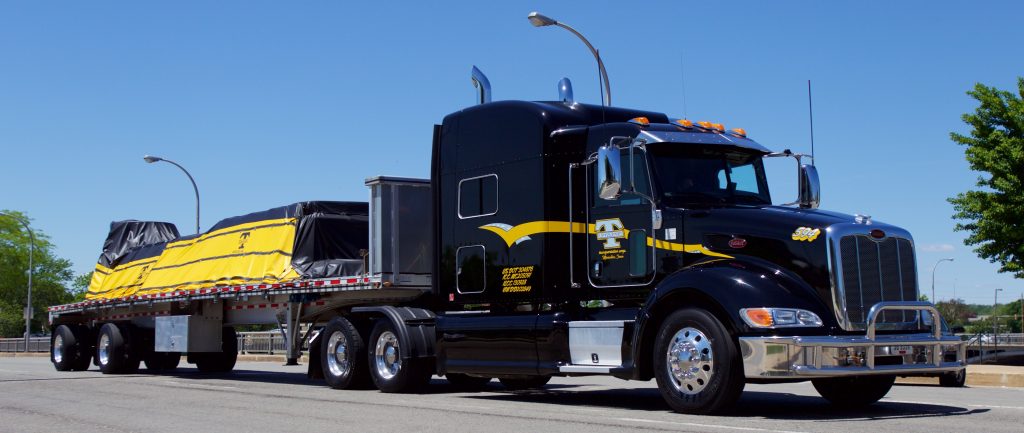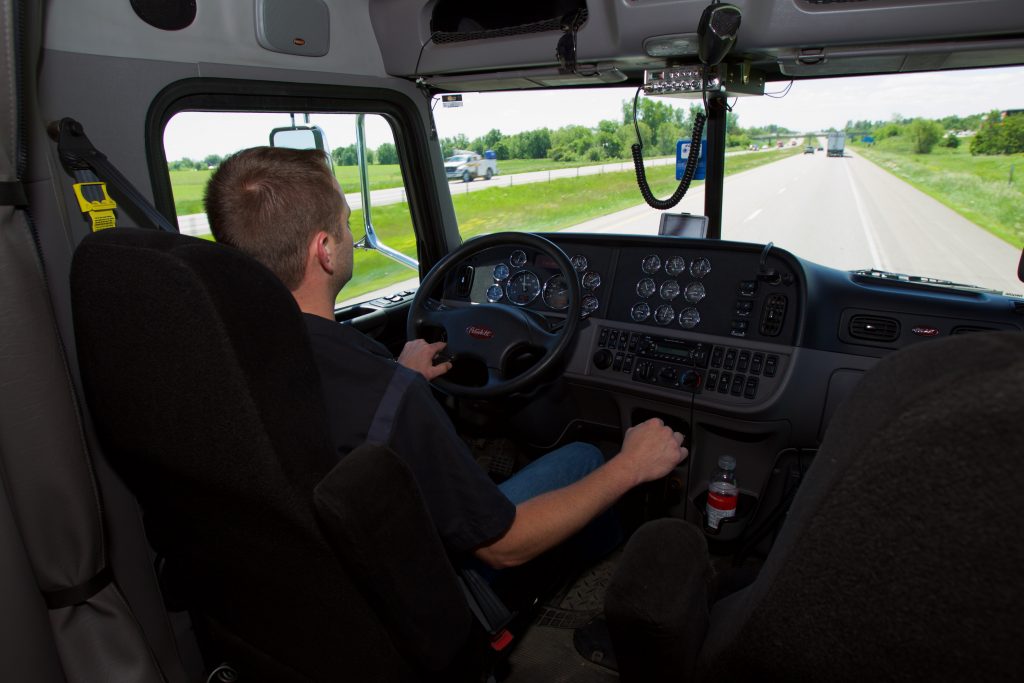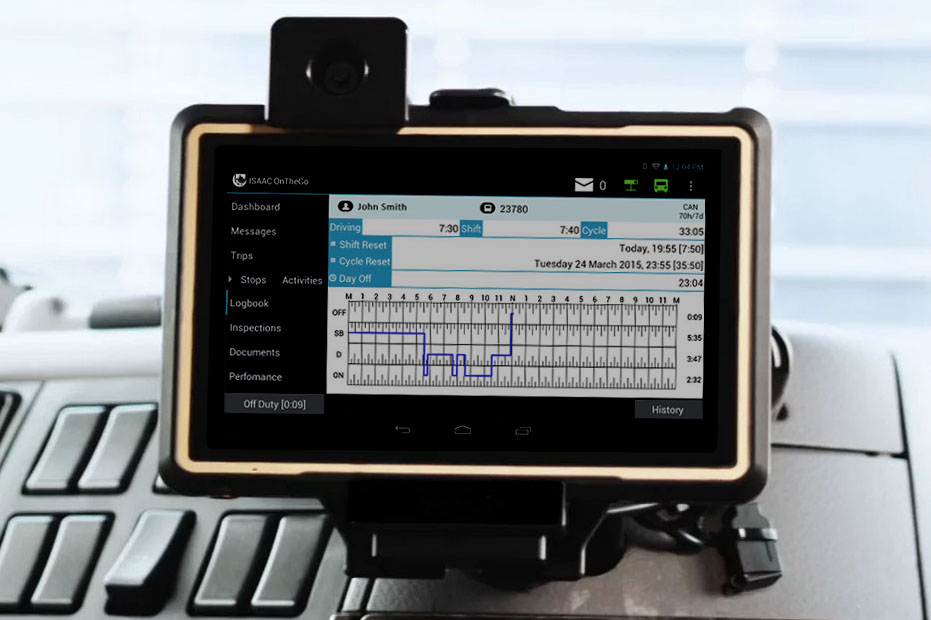Moving Along the Electronic Highway with E-Logs
Truck drivers do much more than simply travel along our nation’s highways and by-ways. They must be highly trained, cautious, and must follow a lot of rules, procedures, and regulations.

“There’s a lot of regs . . . and every day there are more regulations,” said TanTara Safety Director Dave Riggan. “A big part of my job is keeping my drivers educated on what came out of Washington, D.C. to change today.”
As an Iowa transportation company, TanTara hires and trains drivers to run oversized loads and flatbeds. Riggan must make certain his company stays on top of new legislation.
Those with Commercial Driving Licenses (CDL’s)—including truck, flatbed truck, and bus drivers—have long kept paper logs to record their activity. These daily logs chronicle specific types of information, including the motor carrier home address, the home terminal, accidents or breakdowns, state and city names for travel, and a proper tally of on- and off-duty hours.
The United States Department of Transportation (DOT) regulates how many hours a driver can work each day and each week. The rules are intended to protect driver’s safety and the safety of other motorists on the road. The regulations are different for those carrying property and those carrying passengers. A few of the hours-of-service rules for truck drivers include:
-
11-Hour Driving Limit
May drive a maximum of 11 hours after 10 consecutive hours off duty.
-
14-Hour Limit
May not drive beyond the 14th consecutive hour after coming on duty, following 10 consecutive hours off duty. Off-duty time does not extend the 14-hour period.
-
Rest Breaks
May drive only if 8 hours or less have passed since end of driver’s last off-duty or sleeper berth period of at least 30 minutes.
-
Sleeper Berth Provision
Drivers using the sleeper berth provision must take at least 8 consecutive hours in the sleeper berth, plus a separate 2 consecutive hours either in the sleeper berth, off duty, or any combination of the two.
According to TheBalance.com, it’s important for all transportation companies to monitor the log books of their drivers. Keeping on top of the records is a good way to provide feedback to drivers. Companies know they must adhere to the rules. Audits can take time and money. Not following regulations can result in dire consequences. Did you know?
- DOT auditors have total control for writing tickets and issuing fines.
- A safety audit is not the same thing as a compliance review. A safety audit is more educational and company fines are typically lower.
- A driver falsifying a log—or a company that allows a driver to falsify a log—are subject to up to five years in federal prison.
Trucking companies know they must remain ever vigilant about their drivers. Per Section 395.8(k) of the Federal Motor Carrier Safety Regulations, motor carriers must retain supporting documents for at least six months. False driver logs—including miles that don’t add up, time breaks that weren’t taken, accidents that weren’t reported—were listed as the 10th most serious violation in 2015.
Keeping track of hours and filling out paper logs can be very time-consuming for truck drivers. And the consequences of not filing hours properly can be very costly to truck companies. A violation in hours of service can cost between $1,100 to $10,000 per occurrence. That’s a large financial burden for flatbed and trucking companies to bear.
In 2014, the U.S. Department of Transportation’s Federal Motor Carrier Safety Administration (FMCSA) suggested a new way to reduce the paperwork required for truck and bus drivers: electronic logging devices (ELD’s). The proposal was intended to save time and improve safety for truck drivers.
Their research showed that electronic logs would help reduce crashes by fatigued drivers and prevent roughly 20 fatalities and 434 injuries each year.
“The trucking industry is . . . the only industry really out there interacting with the public,” says Riggan. “I mean, we’ve got an 80,000-lb rig rolling down the highway next to your family of four. Safety is huge. If my driver makes one wrong move, it could be devastating.”
In addition to protecting lives, the proposal is designed to protect driver’s privacy. It provides document access only to FMCSA and boosts efficiency for inspectors and law enforcement officers, who can review the driver records electronically. The logs will also protect drivers from harassment by a motor carrier.
The reaction about electronic logs from trucking companies and drivers has been mixed. Some believe e-logs might encourage drivers to drive even harder during their duty time—including during inclement weather, because the electronic clock is ticking—thereby negating the safety goals the measure was crafted to address.
Others see e-logs as a great way to increase accountability within the trucking industry. They believe e-logs will also reduce the chance for payroll fraud by truck drivers. But how much change will come with the introduction of e-logs? How well do regulators understand the life of truckers?
Riggan raises a good point. “The problem is the folks making those rules have never seen the inside of a truck. They’ve never driven a truck.”

Members of the Owner-Operator Independent Drivers Association argue that the proposal doesn’t meet critical legal requirements: that e-logs automatically and accurately record driver hours of service. Why? Under the proposal, drivers will need to manually enter a change in status. This change would not necessarily be accurate and it certainly wouldn’t be automatic.
The 516-page Federal Motor Carrier Safety Administration, 49 CFR Parts 385, 386, 390, and 395, [Docket No. FMCSA-2010-0167], RIN 2126-AB20, Electronic Logging Devices and Hours of Service Supporting Documents is VERY specific.
For example, in a section about log modification, the document states:
The design of the ELD allows only limited edits of an ELD record by both the
driver and the motor carrier’s agents and in either case the original record generated by
the device cannot be changed. Drivers may edit, enter missing information into, and
annotate the ELD records but the original record will be retained. The ELD prevents
electronically-recorded driving time from being shortened. A motor carrier may request
edits to a driver’s RODS to ensure accuracy.
As a compromise, some groups wanted e-logs to have data storage that is hard-wired to the engine. The truck’s operation would be logged even if the portable system is not activated.
Safety directors like Riggan are expected to know the rules backwards and forwards and to follow them to the letter.
“The federal government puts so many regulations on the trucking industry,” he explains. “I feel pretty comfortable in saying that truck drivers are more heavily regulated than airline pilots and we’re not even carrying any passengers.”
Many companies and individuals have weighed in since the proposal was announced in 2014. Trucking companies realize that e-logs would be more accurate and legible and don’t require as much time to analyze. However, the electronic systems cost money to set up and operate.

Some drivers who have already used the system report feeling much calmer and relaxed. Others resent the logs because they can’t run as hard—or make as much money—as they did using paper logs.
Love them or hate them, everyone knows that ELD’s are mandated to take effect by the close of 2017.
Given the mandatory move to e-logs, TanTara wants to hear from you. TanTara is committed to being the best trucking company in Iowa. To achieve that, he believes in listening to his drivers.
Have you implemented the electronic system yet? If not, what are you and your company doing to prepare? What, if anything, will you miss about paper logs? Do you believe paper logs allowed drivers to make more money? What GPS software do you plan to use? Do you believe the implementation of e-logs will make it even more difficult to recruit and retain truckers? Will e-logs make our roads safer? Why or why not? Do you feel e-logs protect driver privacy? How does the electronic system work if you cross into Canada or Mexico? How do you think electronic logs will improve safety and/or change the trucking industry? What are your concerns?